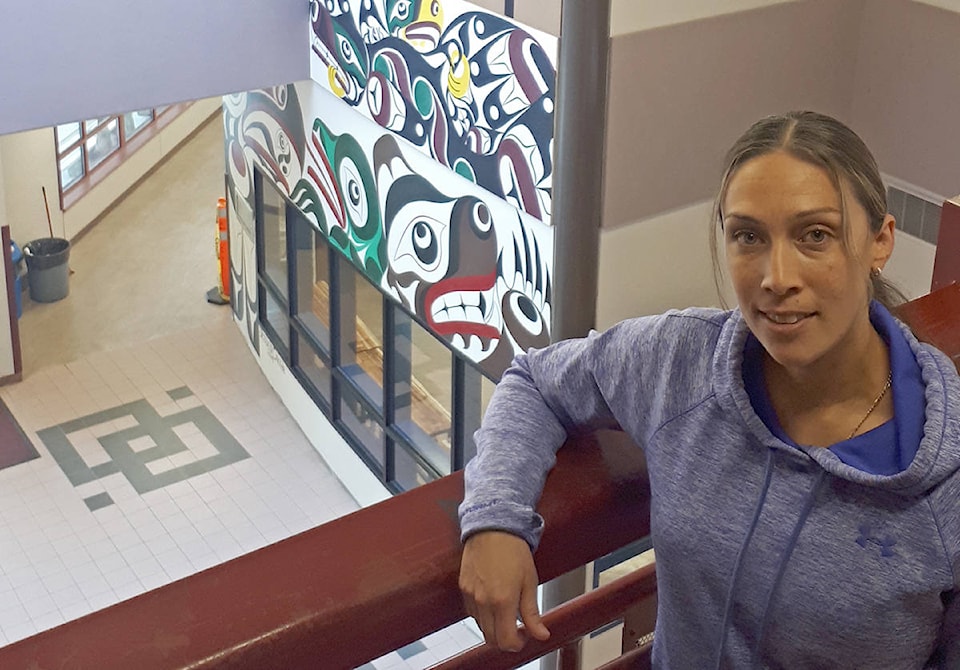When artist Jessica Chickite was little, she would watch her father carve at the kitchen table.
Watching him work and plan his creations, she was inspired from a young age to make art of her own.
And like her father who used to visit her classes to work with students, she has started going into local schools to pass on what she knows, too. Most recently, this connection to schools helped lead to her painting a large mural inside the halls of Timberline Secondary.
“The school is thrilled to be able to have a talented artist like Jessica come in an create a beautiful piece of art. She is terrific to work with, and has taken us a step further toward creating a space that represents the Indigenous students who attend the school,” said Timberline principal Laird Ruehlen. “The school is built on traditional territories, and we feel that the physical space should reflect that.”
RELATED STORY: Aboriginal art murals coming to Carihi
Chickite is a Lekwiltok native artist from the Cape Mudge Band (We Wai Kai), her Facebook page says. She is the great granddaughter of the late hereditary chief Johnny Chickite and daughter of Max and Barbara Chickite. Her husband and her father are both carvers. While she doesn’t carve, she drew inspiration from her upbringing to produce other types of art, especially from her father.
“He’s an artist too, he’s a carver,” she says. “I just used to watch him at the kitchen table painting masks and drawing. He’d draw designs for me to paint…. Eventually, I started drawing my own.”
In her early 20s, she realized art was what she wanted to do. These days, as well as being a mom and working a regular job, Chickite has taken on another couple of mural projects around the community. She typically uses a variety of media in her artwork, such as paper, wood, canvas and deer hide drums.
“It’s my culture,” she says. “I feel like art’s a part of me.”
For the Timberline project, a carver friend referred her to the school, and she got in touch about the project, submitting some ideas, and she was excited to be chosen.
She admits the shape of the wall in the halls makes for an awkward space, but she was able to produce the mural over four weeks.
“I’m not going to lie, it was really hard to design,” she says. “Once I started it, it didn’t too long to complete.”
The art seamlessly came together, as Chickite broke down the space into three components. That the three sections were all different textures, which could affect the appearance of the paint, only made the choice to create the different designs easier.
“I wanted to fit in as much as I could for the kids,” she says.
In the end, she picked different motifs for each section, flowing into a kind of a triptych painting, albeit one oriented vertically rather than horizontally. At the top, she adapted to the shape of the wall and created the top of a Big House with Sisiutl, a double-headed serpent. In the middle section, she created the Thunderbird and Killer Whale. For the the bottom section she used Bear, Frog – fittingly symbolic for knowledge and learning – and Raven and Moon.
“Because of the school, I wanted to have something to do with learning,” she says.
Eventually, she adds, there will be a wolf, the school’s mascot, frosted onto the adjacent windows.
The images she chose not only because they resonated with her but because they also held meaning appropriate to young people in schools, and she credits the school for allowing her the opportunity to create what she wanted.
Funding for the project came from the School District 72’s Indigenous Education Department’s Role Model/Elder Grant. The project was completed in combination with a totem pole, that is soon to be raised. These are aimed at increasing Indigenous students’ sense of pride and ensure their cultures are reflected within the schools.
